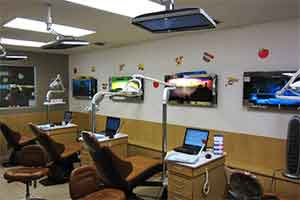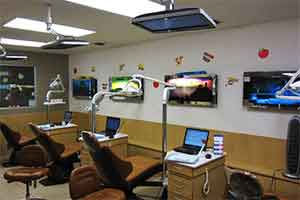Watching cartoons could help children overcome anxiety of dental treatment

 Watching cartoons through video glasses during dental treatment could help lessen children’s anxiety and distress as well as reducing disruptive behaviour, according to a randomized controlled trial published in Acta Odontologia Scandinavica.
Watching cartoons through video glasses during dental treatment could help lessen children’s anxiety and distress as well as reducing disruptive behaviour, according to a randomized controlled trial published in Acta Odontologia Scandinavica.
Anxiety about visiting the dentist and during treatment is common in children. Estimates suggest that as many as 1 in 5 school age children are afraid of dentists. Children with dental phobias end up experiencing more dental pain and are more disruptive during treatment.
Although studies have shown that audiovisual distraction (eg, playing video games and watching TV) can be successful in minimizing distress and the perception of pain during short invasive medical procedures, the issue of whether distraction is beneficial during dental procedures is still hotly debated. Research to date has produced conflicting results.
In this study, 56 ‘uncooperative’ children (aged 7 to 9 years) attending a dental clinic at the Royal College of Dentistry, King Saud University in Saudi Arabia were randomly assigned to receive either audiovisual distraction (watching their favourite cartoons using the eyeglass system Merlin i-theatre™) or no distraction (control group). Children underwent three separate (max 30 min) treatment visits involving an oral examination, injection with local anaesthetic, and tooth restoration. The researchers measured the anxiety levels and cooperative behavior of the children during each visit using an anxiety and behavior scale, and monitored each child’s vital signs, blood pressure, and pulse (indirect measures of anxiety). Children also rated their own anxiety and pain during each procedure.
During treatment, the children in the distraction group exhibited significantly less anxiety and showed more cooperation than those in the control group, particularly during the local anaesthetic injection. What’s more, the average pulse rate of children in the control group was significantly higher during the injection compared with children in the distraction group. However, the children themselves did not report differences in treatment-related pain and anxiety.
The authors conclude that audiovisual distraction seems to be a useful technique to calm children and ensure that they can be given the dental treatment they need. However, they caution that because of the limited number of participants, further larger studies will be needed in general clinical settings to confirm the value of this audiovisual distraction tool.
Source: Taylor & Francis
Full bibliographic information:
Effects of audiovisual distraction on children’s behaviour during dental treatment: a randomized controlled clinical trial
Acta Odontologica Scandinavica Society

